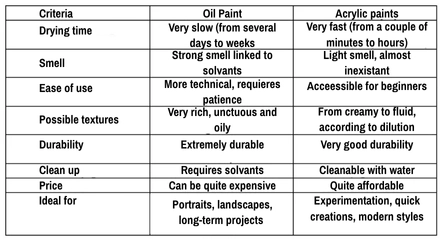Acrylic Paint or Oil Paint: What Are the Differences?

Hello everyone, are you interested in learning how to paint but unsure whether to choose acrylic or oil paints? Or perhaps you've already begun with one and are wondering if the other might suit you better? No worries, you are in the right place! In this article, we will explore the characteristics of these two techniques to help you make your choice with ease.
The History of Acrylic and Oil Painting
Oil painting and acrylic painting are two classics in the world of art, each with its own style and history.
Oil painting has existed for centuries: it was popularized during the Renaissance and allowed the greatest masters — such as Leonardo da Vinci and Rembrandt — to create works of incredible depth and richness. It is a demanding technique, but it is capable of producing results of impressive finesse.
Acrylic, however, is much more recent. Emerging in the 20th century, it was developed to meet the modernity needs of artists: a quick-drying, flexible paint that adapts to almost any surface and offers a palette of vibrant colors. It quickly won over contemporary painters for its freedom and ease of use.
So we're going to compare the two techniques. Note that, to make a good comparison, I am assuming that the two chosen paints will be of equivalent quality. If you want to start with one or the other, I recommend investing in medium-quality equipment; otherwise, you may have a disappointing first experience.
I also invite you to check out the following articles to learn how to get started with acrylics and how to choose your paper.
Let's compare the characteristics of these two techniques
Opacity
Let's start by comparing their opacity. Oil paint often has the advantage: it provides a naturally denser and richer coverage, allowing for layering while maintaining a beautiful depth of color.
Acrylic, however, can be more variable: some shades are very opaque, while others are more transparent, depending on the pigments used. That said, with good acrylic paint and a few adjustments (such as applying several coats), it is entirely possible to achieve a very opaque finish.

Acrylic Oil
The texture
Oil paint is naturally creamier and greasier, which allows for prolonged work on the material, creating very soft blending effects or thick textures with relief.
Acrylic, on the other hand, is lighter and more fluid out of the tube, and it dries much faster, which results in a more "dry" feeling once applied. That said, today there are many mediums available to thicken or texture the acrylic if you like to sculpt the paint!

Oil Acrylic
Blending colors
When mixing colors, acrylic and oil behave differently, whether on the palette or on the canvas. Off the canvas, with acrylic, it is easier to mix different shades because they blend very well. However, with oil being greasier, some colors sometimes have more difficulty mixing to achieve a perfectly homogeneous result.
On canvas, acrylic provides a more raw and textured finish, while oil allows colors to blend smoothly and create more subtle transitions. Acrylic, with its quick drying time, requires quicker and more precise application, while oil, with its slow drying time, allows for longer work on gradients.

Acrylic Oil
The process
Painting with acrylic and oil requires different approaches, especially for gradients and smooth finishes. With acrylic, it is difficult to achieve perfect gradients or very smooth transitions. On the other hand, oil allows you to achieve very precise and blended gradients. Acrylic dries quickly, making it ideal if you wish to paint more spontaneously, whereas oil dries slowly, providing time to retouch and blend colors, but this also requires more time and care in application.
You can also apply the two paints with different tools and vary the thickness of the paint, which allows for diversifying the painting method and creating works that are realistic, suggestive, or even abstract.

The general rendering
We have already discussed this point, but it deserves further clarification. The final result of acrylic is generally quite "raw" and textured. This technique is particularly suited for effects of spontaneity and suggestion, especially if you like to leave visible marks of your tools, such as brush strokes, impressions, or even splashes. Acrylic can therefore convey a certain energy and a more direct style. On the other hand, oil, although it also allows for textured results, is more often used for more delicate work.
Thanks to its slow drying time, oil is particularly well suited to realistic or detailed styles where every shade of color counts, which is one of the reasons why it was so prized by the great masters of painting.

Acrylic Oil
Equipment and Price
We couldn't compare these two techniques without addressing the materials and cost, and oil is certainly more expensive. Acrylic is a relatively affordable painting technique, and especially one that requires little equipment. In this price comparison, I assume that you already own glasses and plates to serve as a water jar and palette. The comparison is also based on equivalences of quality.
For acrylics, you therefore need to invest in paper, brushes and paint. For oils, however, you need much more equipment, and almost everything is more expensive. First of all, you definitely need a canvas, which, being single-use, costs about the same as a pad of paper for acrylic. Then, to prepare this canvas, you will need gesso, linseed oil to thin your colors, turpentine to clean your brushes, and finally, of course, brushes and paint.
As you can see, the equipment for oil painting is a lot more expensive, and if the budget is an important factor, then you should not opt for oil because clearly, it's expensive, very expensive.

Acrylic Oil
Comparative Table Between Acrylic and Oil Paint
Here is a comparative table between the two techniques, which covers the different points we discussed.

Which technique to choose?
If you still don't know which technique to choose, here are some key points:
Your pace:
Quick and spontaneous? ➔ Acrylic.
Patient and in detail? ➔ Oil.
Your space:
Small apartment ➔ Acrylic (less odor, easy cleaning).
Airy workshop ➔ Oil (be careful with solvents).
Your project:
Study work, sketches, illustrations ➔ Acrylic.
Classic project, large formats, long-lasting paintings ➔ Oil.
Your work comfort
Quick drying paint? ➔ Acrylic (convenient for multi-layer rapid painting).
Slow painting, prolonged manipulation? ➔ Oil (ideal for subtle effects and slow transitions).
Your budget:
Small budget? ➔ Acrylic (cheaper, requires less equipment).
Larger budget? ➔ Oil (more expensive, but with a rendering that can justify the investment).
Your project type:
Express or small-scale projects? ➔ Acrylic (better suited for smaller formats, faster).
Large-scale projects? ➔ Oil (large formats and fine details lend themselves well to oil).
Your artistic approach:
Do you prefer a fluid texture, a quick application? ➔ Acrylic (easy to work with, less waiting between coats).
Do you like rich textures and layering effects? ➔ Oil (perfect for thin layers and depth effects).
Your style:
Modern, spontaneous, abstract? ➔ Acrylic (ideal for dynamic and bold work).
Classic, detailed, realistic? ➔ Oil (known for its ability to render light and textures with finesse).
In summary, the choice between acrylic and oil depends on your working style and priorities. Acrylic is fast, affordable, and versatile, while oil offers deeper rendering but requires more patience and equipment.
It's up to you to choose the technique that matches your pace, your projects, and your budget because each medium has its own advantages.
I hope you enjoyed this article! 😊
Writer and illustrator: Chloé Pouteau

